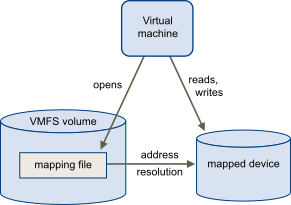An RDM is a mapping file in a separate VMFS volume that acts as a proxy for a raw physical storage device. With the RDM, a virtual machine can access and use the storage device directly. The RDM contains metadata for managing and redirecting disk access to the physical device.
The file gives you some of the advantages of direct access to a physical device, but keeps some advantages of a virtual disk in VMFS. As a result, it merges the VMFS manageability with the raw device access.

Typically, you use VMFS datastores for most virtual disk storage. On certain occasions, you might use raw LUNs or logical disks located in a SAN.
For example, you might use raw LUNs with RDMs in the following situations:
- When SAN snapshot or other layered applications run in the virtual machine. The RDM enables backup offloading systems by using features inherent to the SAN.
- In any MSCS clustering scenario that spans physical hosts, such as virtual-to-virtual clusters and physical-to-virtual clusters. In this case, cluster data and quorum disks are configured as RDMs rather than as virtual disks on a shared VMFS.
Think of an RDM as a symbolic link from a VMFS volume to a raw LUN. The mapping makes LUNs appear as files in a VMFS volume. The RDM, not the raw LUN, is referenced in the virtual machine configuration. The RDM contains a reference to the raw LUN.
Two compatibility modes are available for RDMs:
- In the virtual compatibility mode, the RDM acts like a virtual disk file. The RDM can use snapshots.
- In the physical compatibility mode, the RDM offers direct access to the SCSI device for those applications that require lower-level control.